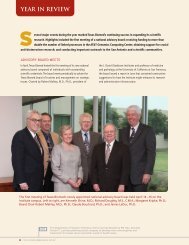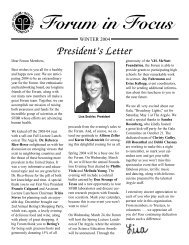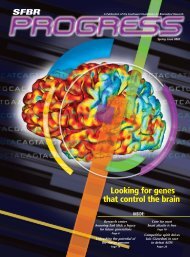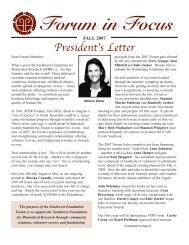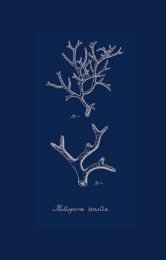Texas Biomed Science Report 2011-2012 - Texas Biomedical ...
Texas Biomed Science Report 2011-2012 - Texas Biomedical ...
Texas Biomed Science Report 2011-2012 - Texas Biomedical ...
Create successful ePaper yourself
Turn your PDF publications into a flip-book with our unique Google optimized e-Paper software.
Jeff T. Williams, Ph.D.<br />
Associate Scientist, Genetics<br />
Whereas ten years ago statistical models involving one or a<br />
few genes were adequate to the task, the immense and complex<br />
datasets generated by the current generation of molecular genetic<br />
technology are driving the development of novel statistical<br />
methods for understanding the dynamics of gene networks and<br />
biochemical pathways. Following theoretical investigation, extensive<br />
computer simulation studies are generally required to elucidate<br />
the properties of competing or alternative statistical methods.<br />
Williams’ laboratory is engaged in an ongoing collaborative project to<br />
develop the baboon as a nonhuman primate animal model for primary<br />
generalized epilepsy in humans. It has been recognized since the mid-<br />
1960s that baboons are susceptible to naturally-occurring spontaneous<br />
seizures, and exhibit a high prevalence of photosensitive epilepsy.<br />
In this regard the baboon is absolutely unique among the primates:<br />
spontaneous seizures are uncommon in other species of monkey and<br />
are not observed at all in any of the ape species. The reasons for the<br />
unusual sensitivity of the baboon to spontaneous seizures are not yet<br />
understood, but the high prevalence of the condition, and its clinical<br />
similarity to human juvenile myoclonic epilepsy, make the baboon an<br />
exceptional model for understanding the genetics of epilepsy in humans.<br />
Previously Williams directed a comprehensive electroencephalogram<br />
evaluation of more than 700 pedigreed baboons from <strong>Texas</strong> <strong>Biomed</strong> to<br />
characterize the clinical features of their epilepsy. The current research<br />
focus is now on adapting conventional neuroimaging modalities,<br />
such as functional MRI and perfusion positron-emission tomography,<br />
<strong>2011</strong>–<strong>2012</strong> Scientific <strong>Report</strong><br />
“The primary activity in my laboratory is theoretical statistical genetics and applied statistical computing.<br />
The ever-changing nature of genetic data demands a commensurate effort of pure and applied statistical<br />
research to develop new models and computational methods for gene discovery and characterization.”<br />
Publications<br />
• Anderson TJC, Williams JT, Nair S, Sudimack D, Barends M, Jaidee A, Price RN, Nosten F<br />
(2010) Inferred relatedness and heritability in malaria parasites. Proc Biol Sci Aug<br />
22;277(1693):2531–40.<br />
• Szabó CÁ, Kochunov P, Knape KD, McCoy KJM, Leland MM, Lancaster JL, Fox PT, Williams<br />
JT, Rogers J (<strong>2011</strong>) Cortical sulcal areas in baboons (Papio hamadryas spp.) with generalized<br />
interictal epileptic discharges on scalp EEG. Epilepsy Res Feb;93(2-3):91–5.<br />
• Szabó CÁ, Narayana S, Franklin C, Knape KD, Davis MD, Fox PT, Leland MM, Williams JT<br />
(2008) "Resting" CBF in the epileptic baboon: correlation with ketamine dose and interictal<br />
epileptic discharges. Epilepsy Res Nov;82(1):57–63.<br />
• Williams JT, Mubiru JN, Schlabritz-Loutsevitch NE, Rubicz RC, VandeBerg JL, Dick Jr EJ,<br />
Hubbard GB (2009) Polymerase chain reaction detection of Trypanosoma cruzi in Macaca<br />
fascicularis using archived tissues. Am J Trop Med Hyg Aug;81(2):228–34.<br />
• Szabó CÁ, Leland M, Sztonák L, Restrepo S, Haines R, Mahaney MC, Williams JT (2004)<br />
Scalp EEG for the diagnosis of epilepsy and photosensitivity in the baboon. Am J Primatol<br />
62(2):95–106.<br />
• Williams JT, Blangero J (2004) Power of variance component analysis II. Discrete Traits. Ann<br />
Hum Genet 68(6):620–32.<br />
• Williams JT, Blangero J (1999) Power of variance component linkage analysis to detect<br />
quantitative trait loci. Ann Hum Genet 63(6):545–63.<br />
for use with epileptic baboons. The immediate goal is to develop a<br />
reliable neuroimaging protocol that can accurately and reproducibly<br />
measure changes in cerebral blood flow that occur during seizures.<br />
Williams is also investigating techniques for mapping the<br />
spatial (dis)organization of neuronal impulses in the brain during<br />
seizures. Ultimately, the development of neuroimaging and neuronal<br />
mapping in the baboon will provide the clinical research tools for<br />
noninvasive assessment of therapy with antiepileptic drugs.<br />
E For more information, please visit www.txbiomed.org/departments/<br />
genetics/genetics-staff-bio?u=56<br />
21




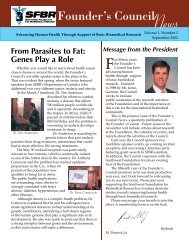
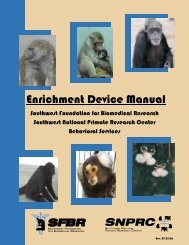
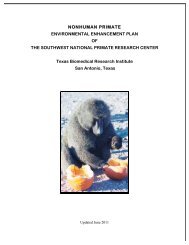
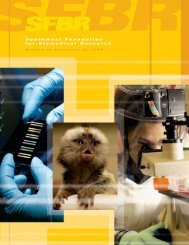
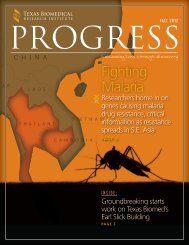
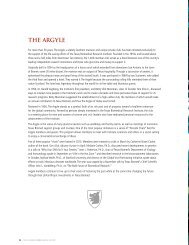
![Vol. 8 No. 2, 2011 [PDF] - Texas Biomedical Research Institute](https://img.yumpu.com/35688099/1/190x245/vol-8-no-2-2011-pdf-texas-biomedical-research-institute.jpg?quality=85)

